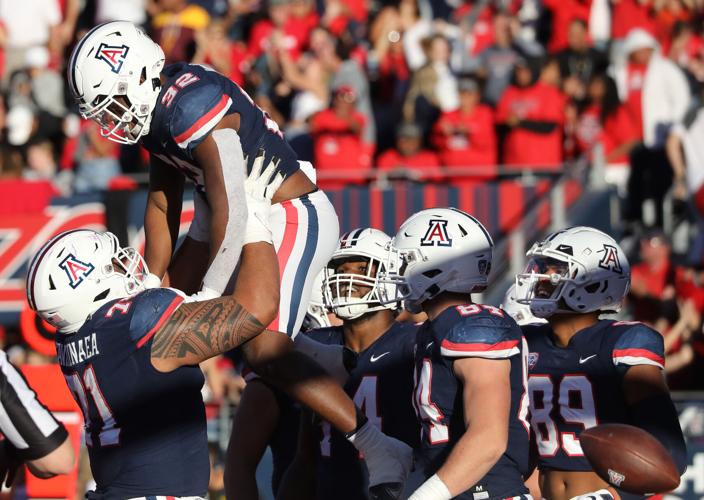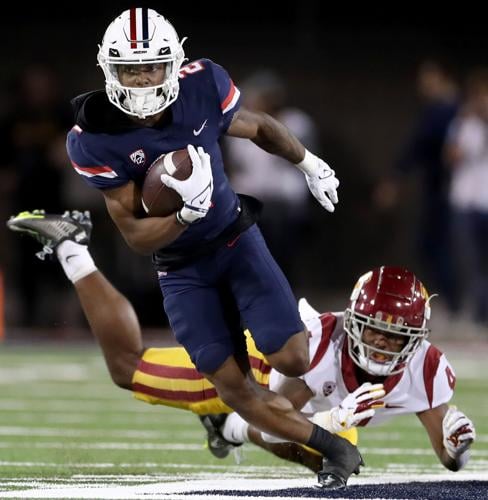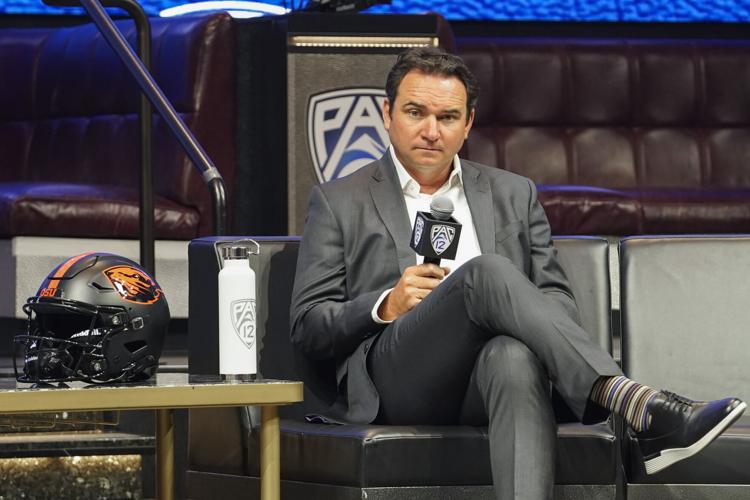After Arizona finished its scrimmage Saturday night, an image was displayed on the Arizona Stadium scoreboard.
It said, “NEXT UP,” and it included all the details of the Wildcats’ Sept. 2 opener against NAU.
The “NEXT UP” part wasn’t entirely accurate, at least not for the coaches and players; they still have two weeks of practice to get ready for the 2023 season.
But the training-camp portion of their prep essentially ended when Tyler Manoa blocked a field-goal attempt to punctuate an entertaining, if somewhat sloppy, dress rehearsal.
Having taken in eight of the 11 open practices, including both scrimmages, I offer the following five takeaways on the ‘23 Wildcats:

Arizona lineman Jonah Savaiinaea lifts up running back DJ Williams after Williams scored the go-ahead touchdown in the fourth quarter against Arizona State at Arizona Stadium on Nov. 25, 2022.
1. Real depth
It’s been a multistep, multiyear process to get to this point, but I feel safe in saying Jedd Fisch and his staff have built a roster that has legitimate depth at most positions.
Jonah Coleman and DJ Williams easily could start at running back. Likewise Kevin Green Jr. and AJ Jones at wide receiver.
Defensive coordinator Johnny Nansen said he plans to play 8-9 defensive linemen; he rotated liberally up front throughout camp.
Daniel Heimuli and Justin Flowe have battled to a draw at “Mike” linebacker. Nansen described their ongoing competition as “neck and neck.”
(Factoring in Flowe’s extra protective gear, it’s actually neck and neck pad. But I digress.)
Tacario Davis is an impressive-looking young cornerback, but transfer Dylan Wyatt might bump him to the second unit. At safety, Arizona has four viable options for two spots.
But to me, the real sign of real depth can be found in who isn’t expected to have a big role this season. For example: Freshman linebackers Taye Brown (listed at 6-2, 230) and Leviticus Su’a (6-2, 235) look the part. But they might not be quite ready. Barring injuries, Arizona doesn’t have to play them this year.
This isn’t a perfect comparison, because USC always has recruited at a higher level, but when I covered the Trojans, they regularly had talented freshmen running with the third team. Those players either played on special teams or redshirted.
That’s how it’s supposed to work. Arizona is finally on that same trajectory.

Michael Lev is a senior writer/columnist for the Arizona Daily Star, Tucson.com and The Wildcaster.
2. Better run D?
Arizona’s defensive front looks better. It’s definitely bigger. Will that translate into improved play against the run?
Because the Wildcats didn’t tackle Saturday night — and didn’t for most of camp — it’s hard to tell. As Fisch said, it was difficult at times to differentiate a 3-yard run from a 30-yarder.
The Wildcats ranked 123rd out of 130 FBS teams in run defense last season, surrendering 209.1 yards per game. They allowed 5.59 yards per attempt, which ranked 125th. They have a long way to go.
The staff’s strategy to attack that problem makes a ton of sense. Arizona added size and experience through the transfer portal, and it appears three transfers will start on the defensive line: tackles Manoa (6-5, 315) and Bill Norton (6-6, 325) and end Taylor Upshaw (6-5, 270).
The second wave features another 300-plus-pound transfer, Sio Nofoagatoto’a (6-3, 330), and two homegrown sophomores in Jacob Kongaika and Ta’ita’i Uiagalelei, who’ve put on 15 and 25 pounds, respectively, since last year.
It looks promising on paper. But we won’t really know until Week 2 when Arizona faces a Mississippi State offense that’ll be much more balanced than during the Mike Leach era and features five veteran linemen all tipping the scales at 300-plus pounds.

Arizona quarterback Jayden de Laura speaks to assembled media during the Wildcats' 2023 preseason media day at the Cole and Jeannie Davis Sports Center on Aug. 1.
3. De Laura’s development
It’s been interesting to watch Jayden de Laura’s evolution as a quarterback since he arrived in Tucson in January 2022.
He clearly — and unsurprisingly — felt uncomfortable in a new and radically different offensive system at the outset. About halfway through last year’s training camp, something clicked and de Laura started to cook.
He had a prolific first season as a Wildcat in many ways — throwing for the third-most yards (3,685) and sixth-most touchdowns (25) in UA history but also leading the Pac-12 in interceptions (13). Most of the picks stemmed from de Laura’s competitive nature — trying to do too much, to make something out of nothing.
In recent practices, including the scrimmage, I’ve been impressed with de Laura’s decision-making. He’s been getting the ball out of his hand, even if it’s just a simple pass over the middle to tight end Tanner McLachlan or a checkdown to tailback Michael Wiley.
Even de Laura’s interception Saturday night wasn’t a bad decision. De Laura recognized that Montana Lemonious-Craig had a one-on-one matchup downfield with Charles Yates Jr. De Laura simply underthrew the post route, giving Yates a chance to undercut the pass.
De Laura appears to be operating the offense at a higher level — or, should I say, operating within the offense at a higher level. He’s starting to recognize that he has big-time skill players around him who can do the heavy lifting. Speaking of which ...

Arizona wide receiver Jacob Cowing (2) outruns USC defensive back Max Williams (4) in the fourth quarter of their Pac-12 football game at Arizona Stadium on Oct. 29, 2022.
4. They got skills
It’s easier to build up a stockpile of skill-position players than it is to find big, athletic linemen who can really play. You need both to win consistently, and Fisch and his staff have made great strides on both fronts.
Just because it’s easier to acquire skill guys doesn’t mean it’s easy. Arizona has exceeded expectations on that front in two regards: signing and developing elite talent, and putting together a collection of players who offer versatility and variety.
Receivers Jacob Cowing and Tetairoa McMillan are elite. Both will play in the NFL.
Cowing has superior speed and quickness. He’s undersized, and that will pigeonhole him as a slot receiver, but that’s OK; you can have a long career excelling from the slot.
McMillan has it all, and he’s just starting to realize it. Whatever the over/unders are for T-Mac’s catches, yards and touchdowns this season, I’ll take the over.
Green is Cowing’s understudy and has a similar skill set. AJ Jones has a McMillan-esque build and game. Lemonious-Craig is the most physical receiver of the bunch.
McLachlan will get NFL looks. His understudy, Keyan Burnett, is oozing with athleticism and just scratching the surface. They’re listed at 6-5 and 6-6, respectively; both are 245 pounds.
Wiley is smooth, hard to bring down and as good a receiver as any running back in college football. Coleman and Williams — both listed at 225 pounds — are stocky and powerful yet quick enough to burst through holes. Coleman provided one of the highlights of the scrimmage when he knocked linebacker Brandon Craddock off his feet while blocking on a kickoff return.
Whether blocking, running or catching, it’s an intriguing group.

Oregon State coach Jonathan Smith answers questions at Pac-12 Football Media Day on Friday, July 21, 2023, in Las Vegas.
5. Middle of the Pac?
OK, time for the reality check. Optimism is always overflowing this time of year. The Wildcats look good, no doubt; they’re unquestionably a bigger, faster, deeper team than we’ve seen in a while.
How that translates into wins and losses in the rugged Pac-12 remains to be seen.
Five Pac-12 teams made the preseason Associated Press Top 25, for what it’s worth, and none was Arizona. In Athlon Sports’ conference unit rankings, the Wildcats managed no better than a fifth (for receivers), and their defensive groups ranked 12th (defensive line; likely published before the acquisitions of Upshaw and Nofoagatoto’a), 10th (linebackers) and 11th (defensive backs).
Those are all subjective, of course. But it speaks to the strength of the league this year (and the irony that it was deemed not valuable enough to continue existing).
Offensive line depth and inexperience remain worrisome. The defense as a whole still has a lot to prove.
Arizona is headed in the right direction. Fisch has the Wildcats on a similar path to Oregon State under Jonathan Smith. Excluding the COVID-shortened 2020 season, the Beavers have gone 2-10, 5-7, 7-6 and 10-3 under Smith. Arizona went 1-11 and 5-7 in Fisch’s first two years.
I like how it’s trending.








